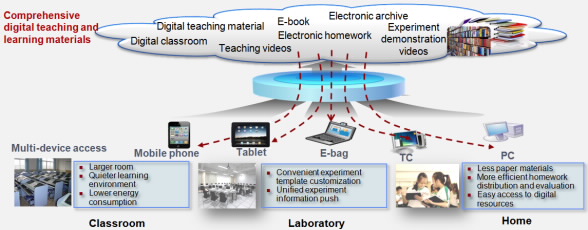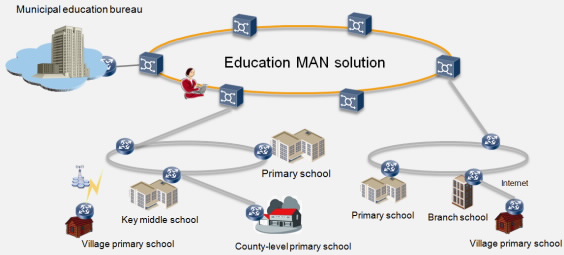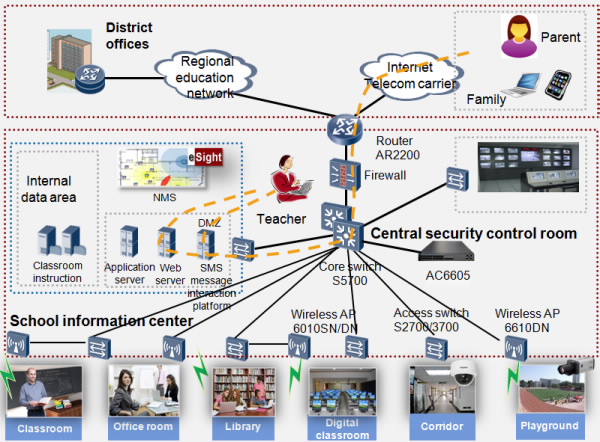Solución e-Education regional
To improve the quality of education in community schools, Huawei has developed an e-Education platform that uses cloud computing and high-speed Internet technologies to create better training and learning opportunities for teachers and students, to increase efficiency and productivity in regional education operations and management, and to enable digital media resource access and sharing from any location at any time.
1.Requirements and Challenges
IT-based education, also known as the e-Education, is undergoing rapid development, especially in the area of basic education. Traditional school organizations are transforming into region-based, resource-sharing enterprises. This centralization of teaching operations is expected to solve many of the problems associated with traditional education models, such as operations inefficiency, duplicate investment, education resource segmentation, and decentralized administration. When high-quality education resources are converged within a region, educators can work together through comprehensive sharing, collaboration, and communications to make significant improvements to the quality of education services.
The integration of services and systems for multiple schools and departments brings the following requirements and challenges to the IT education infrastructure:
- The regional education information center must support better network, storage, and security systems to meet the need for massive, concurrent data processing.
- Most regional education networks and schools do not have sufficient bandwidth resources and require equipment upgrades to support high bandwidth services.
- A unified service system is required to enable multiple management systems to exchange data.
2.Huawei Solution
Huawei's regional e-Education solution integrates education resources into a unified cloud system where data-intensive digital education resources, such as digital teaching materials, teaching videos, e-books, and demonstration videos, are available as needed throughout the region. The high-speed, reliable network enables teachers and students to access and use a multitude of education resources in the cloud system.

Figure 2-1 Regional e-Education solution architecture
The Huawei regional e-Education solution comprises the following sub-solutions:
- Regional education service platform solution
- Regional education data center solution
- Education MAN solution
- Digital school network solution
2.1 Regional Education Service Platform Solution
2.1.1 Application Scenario
Quality education starts with teachers. Teacher training in new technologies and effective methodologies forms a vital part of the quality of education that students receive. Traditional classroom methods, such as teacher demonstration, discussion, and communication, have limited effects. Regrettably, only a small number of teachers receive training in advanced technologies, and those teachers cannot easily share their knowledge with others. Increasing teacher training or the frequency of training brings additional workloads to stretched school districts and takes time away from innovation and research in other areas.
2.1.2 Solution Description
The Huawei regional e-Education service platform is a unified portal that provides cloud education services for high schools, middle schools, and primary schools. The e-Education platform enables teachers and students to teach, learn, discuss, and communicate ideas and issues from anywhere, at any time.
With the e-Education platform and anywhere, anytime access, data interworking and communication problems disappear. Teachers, students, parents, and school administrators can access the set of services made available to them according to their user rights. Schools within the district can access the management website on the service platform to manage classroom instruction. School administrations can access e-Education management services as well as view, monitor, and collect data of subordinate organizations and schools for improved decision-making and guidance.

Figure 2-2 Regional education service platform solution architecture
2.1.3Highlights
The Regional e-Education Solution offers the following benefits:
- A service platform based on cloud architecture provides flexible resource distribution for resource utilization gains of 75% or higher.
- The system automatically balances the load of servers and service systems, ensuring optimal response times.
- Comprehensive, web-based maintenance tools enable efficient system management and maintenance.
2.2 Regional Education Data Center Solution
2.2.1 Application Scenario
The regional education data center distributes basic resources to departments and schools. The datacenter provides core services, such as computing, storage, and backup. The data center also serves as the public operations environment for key application systems, such as regional education resource management, school registration, and curriculum management. The regional data center has the following requirements:
- High security and scalability
- Easy and convenient system operations and management
- Low operating and maintenance costs
2.2.2 Solution Description
The Huawei regional education data center solution uses state-of-the-art cloud computing technologies to create a resource-sharing platform. The solution features high-performance computing, quick and flexible service expansion, and easy-to-use management features. Most importantly, the solution provides a reliable and maintenance-free centralized services environment for education organizations, teachers, and students by merging network, computing, and storage resources into a unified management system that provides service and application hosting services as well as distribution of resources to schools as needed.
The regional data center desktop cloud system virtualizes a portion of computing and storage resources for PCs. Teachers and students in schools use small-sized, Thin Clients (TCs) to access Virtual Machines (VMs), which operate in the same way as a physical PC. The solution manages and maintains VMs in a unified manner using data center servers, which eliminates maintenance and upgrades of individual physical PCs, improves the efficiency of computing resources with fast Time-Division Multiplexing (TDM) access, and lowers infrastructure procurement and maintenance costs for service and system upgrades.

Figure 2-3 Regional education data center solution architecture
2.2.3Highlights
The Regional e-Education Solution offers the following benefits:
A comprehensive security structure provides layered protection for technologies, services, and management systems.
The modularized data center uses optimized energy-saving, cooling, and power supply solutions.
The resource pool features flexible sharing, and automatic dispatching supports quick development, deployment, and upgrade.
2.3 Education MAN Solution
2.3.1 Application Scenario
The education Metropolitan Area Network (MAN) requires a flexible network design with proven communications technologies to connect schools in the computing network with high bandwidth, reliability, security, and Internet interconnection support. The education MAN is a comprehensive, service-bearing network that delivers essential services such as video conferencing, phone conferencing, collaborative office, email, and school registration management. The education MAN must deliver services reliably and efficiently, ensure network reliability, and support smooth upgrades to services or the network.
2.3.2 Solution Description
Huawei's education MAN solution uses MAN Optical Transport Network (OTN) technologies to divide the network into core, convergence, and access layers. Management personnel can define multiple Virtual Private Networks (VPNs) for departments and schools, further enhancing service security and resource utilization.
The solution provides multiple advanced network services, such as video conferencing, entrance examination services, remote education, resource sharing, and data management for schools within the region. The solution also uses a unified network egress, IP address, and domain name for network protection and deploys Denial of Service (DoS), firewall, antivirus center, and information filtering devices in the MAN egress to ensure network stability and information security within the network.

Figure 2-4 Education MAN solution architecture
2.3.3Highlights
The Regional e-Education Solution offers the following benefits:
Fast, large-bandwidth service delivery, enabling quick end-to-end interconnection
Simplified networking and system maintenance, improving system integration and reducing interconnection and maintenance workloads
High network survivability and reliability with intelligent network protection features
40 GE transmission capability, supporting smooth upgrade to 100 GE
2.4 Digital School Network Solution
2.4.1 Application Scenario
The digital school represents the last mile of the regional e-Education solution. Most schools now have computer and multimedia classrooms and more teachers are accessing the Internet and other education and research networks to prepare and perform teaching activities. The increasing number of digital applications in schools, however, brings more complexity to school network and IT facility management. IT system maintenance personnel devote much time and energy to device maintenance, system upgrades, and antivirus and security protection for the network.
2.4.2 Solution Description
Huawei's digital school network solution integrates wired and wireless networks in a layered networking architecture. To suit the specific needs of education networks, Huawei employs Quidway series high-speed L3 line switches to perform wired speed forwarding, L3 interconnection, and wired speed multi-layer policy filtering. These switches provide VLAN service isolation, interconnection control, and flexible system expansion of services as well as efficient routing of network traffic.
For campus wireless network deployments, Huawei uses a large-capacity Access Controller+FIT Access Point (AC+FIT AP) network architecture. The solution uses the eSight network management system to manage outdoor APs in a unified manner, enabling automatic AP discovery, maintenance, and upgrade without manual AP configuration.

Figure 2-5 Digital school network solution architecture
2.4.3Highlights
The Regional e-Education Solution offers the following benefits:
Wired and wireless access, unified system management, and easy service expansion
Flexible networking that features wired and wireless integration
Large-bandwidth switches, APs, and routers that meet the requirements for high-quality services
Innovative low-power consumption devices that feature intelligent power supply and energy-saving technologies
